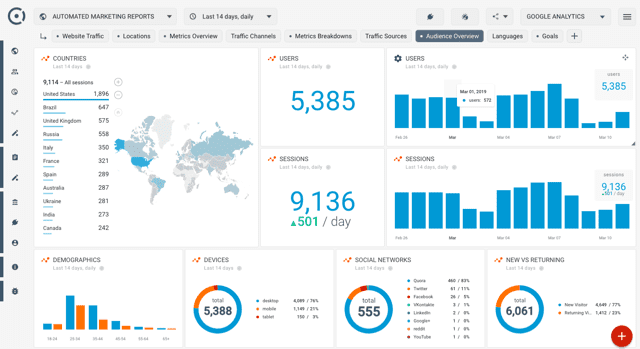Search engine optimization (SEO) is all about driving more organic traffic to your website, but leading brands know that SEO can be used for a lot more. With the right strategy, you can also use SEO to build your brand and pull in more customers just on the strength of your identity.

Table of Contents
Optimization & Branding: What’s The Connection?
SEO involves making technical edits, optimizing older content, and posting new optimized content to draw more visitors and rank well on search engine results pages. Many agencies treat branding and SEO as two distinct objectives, aiming to target non-branded keywords while tracking branded performance separately.
Non-branded keyword rankings are still important, and there’s no doubt that tracking them is an invaluable part of any SEO strategy. However, newer agencies are playing with the idea that branding and optimization both serve the same purpose, and the results have been notable.
Brand building with SEO advances this idea. This approach recognizes that SEO doesn’t just increase the quantity of traffic but also the quality and aims to build trust with users and search engines. If executed well, SEO branding can attract visitors who are more likely to convert, all while building brand awareness. The result of all this is that your brand itself becomes a source of traffic.
Building a Brand
UX & Loyalty
58% of consumers will always shop with a familiar brand, even if it’s not the highest rank on a SERP. One of the biggest reasons consumers even have a favorite brand is the user experience (UX). If a website is easy to navigate and feels great, there’s a good chance your visitor will become a lifelong customer. Design, navigation, and UX, in general, is a key part of SEO branding.
- Design: Your website should immediately catch the eye and invite visitors to explore. Businesses tackle this brand-building SEO challenge differently. H&M’s website follows a simple but straightforward layout, listing products in a grid with contrasting menu buttons for easy navigation – most apparel websites follow this template. On the other hand, Zara is infamous for its very abstract design. The sidebar hides behind a similarly colored image, and even the search bar can be hard to spot.

Both of these examples represent opposites when it comes to SEO branding, so why do both of them rank well?
The answer: authenticity. Zara uses branding to reflect its personality. Customers like Zara for its bold and innovative ideas, which allows the brand to capitalize on its image and stand out from the competition. It’s worth pointing out that below the abstract exterior, the website includes tons of great AR-based usability features. The lesson here is that you don’t have to pursue a cookie-cutter design – as long as it serves your brand’s story.
- Performance: An excellent browsing experience is necessary for SEO branding. Websites that load fast and follow a clear architecture with minimal duplicate pages are easier to crawl for Google and encourage users to spend more time on them. Google uses visitor engagement data to determine whether a page is relevant for a topic or keyword. If you can keep visitors engaged with your pages with helpful and snappy content, it can demonstrate to Google a strong association between the products you’re selling and your brand.
Capitalize on TOFU
Zara’s SEO branding strategy works because shoppers know about the brand from its offline presence and what to search for. So, how do you do brand building for smaller businesses that might not have that same presence? This is where top-of-the-funnel (TOFU) marketing comes in.
TOFU strategies target buyers that are at the start of their journey. At this stage, they know they want to buy a particular product, but they might still need to be made aware of your brand. Here are two ways you can change that.
- Blogs: 71% of shoppers will go through a blog at some point in their buyer’s journey – usually at the start. Blogs are an excellent opportunity to introduce your brand to an all-new audience. The potential to use SEO for branding is endless here. Instead of going for the hard sell, try creating informative SEO content that nudges readers toward your products/services as a solution. Helpful blogs are great for engagement, they’re shareable, and demonstrate your brand’s authority in your niche.
- Infographics: Infographics are compact images that can deliver a ton of information at a glance and help build your brand with SEO through social signaling. It’s likely that some buyers won’t have the patience to go through a long blog to find an answer. If your infographics can provide those answers quickly, they might get shared around. This signals to potential shoppers that your brand is associated with a particular topic and builds awareness.
We are still determining how exactly Google might be taking social signals into account for rankings, but we do understand that signaling plays a role in brand awareness and driving traffic.

Link Building
85% of marketers agree that link building plays a huge role in both branding and SEO. There are two big reasons link building needs to be a part of your SEO brand-building strategy.
- Search Engines: Links function as bridges between more authoritative websites and yours. When you build links through guest blogging, social media sharing, or editorial links, you show search engines that your brand is a trusted entity in this space. According to Google’s E-E-A-T (Experience-Expertise-Authority-Trustworthiness) guidelines, websites that demonstrate these qualities rank better. Remember that natural editorial links are the goal here, and chasing spammy links for branding and SEO can penalize your website. You can earn these editorial links by posting helpful and fluff-free content.
- Users: Links demonstrate your brand’s authority to search engines and users. For instance, if someone is reading a listicle about comfortable pillows on a reputed website like Forbes, they’ll be more willing to take a chance on a linked brand even if they haven’t heard of it before. A part of readers’ trust in established brands gets transferred to yours through linking.
Measuring SEO Branding
Monitoring your SEO results can help you understand how to improve your strategy. There are a couple of great tools that can make this step easier.
- Google Analytics: Use this powerful tool to track your brand’s growth over time. One way to measure brand awareness with Google Analytics is to monitor direct homepage traffic. This is a measure of the amount of people who are accessing your website directly via the address bar. Direct traffic can help us estimate how many people know about and are interested in your brand.

- Google Keyword Planner: Use Google Keyword Planner to track organic traffic for a set of keywords. We can use this to measure SEO branding results by, for instance, tracking branded keywords. Branded keywords include the name of your brand or product. Growth in these search terms can indicate growing brand awareness.
- Third-Party Tools: Third-party tools like Ahrefs or Moz come with built-in and automated SEO features for brand-building. For a price, you can use these tools to estimate your brand’s performance over time.
Empower Your Branding With SEO
Businesses with a strong identity understand that branding and optimization go hand-in-hand. A great link-building strategy, helpful content, and smart design can supercharge your brand. If you would like assistance building that winning strategy, contact Coalition Technologies for a free consultation. Our SEO experts have turned growing businesses into household names with tried-and-tested strategies that get results, and we would love to work with yours!
Frequently Asked Questions
What is branding?
Branding is the process of creating a company’s identity or story. Many factors play into creating a brand, such as its logo, design language, or even unique UX elements. For example, Apple will always go for clean, snappy, and minimalist website designs to fit and build on its premium brand.
What’s the difference between branding with SEO and branding with social media?
Building a brand with SEO and building one with social media are entirely different processes, but they can complement each other if done correctly. Branding through SEO revolves around crafting content and pages that will rank well in search engines for specific (often branded) keywords. The goal is to increase your traffic and conversions while building brand awareness.
On the other hand, branding with social media focuses more on using your content and voice consistently to tell the story you want your brand to represent. Businesses that want to build a brand with social media will look to engage and connect directly with their audiences, along with incentivizing them for that engagement with rewards like giveaways or shoutouts. Some brands will try to combine both of these concepts by including keywords in their social media posts to nudge them toward their websites.
What is the best time to start building my ecommerce brand?
In ecommerce, the best time to start building a brand is yesterday. SEO branding only gets more effective the earlier you begin. It takes time to plan out the kind of story you want to tell with your products, and then to figure out the best way to execute that plan. Which social media platforms will you prioritize? What kind of branded keywords should you target? Building a brand early with SEO can net you a tremendous competitive advantage.

